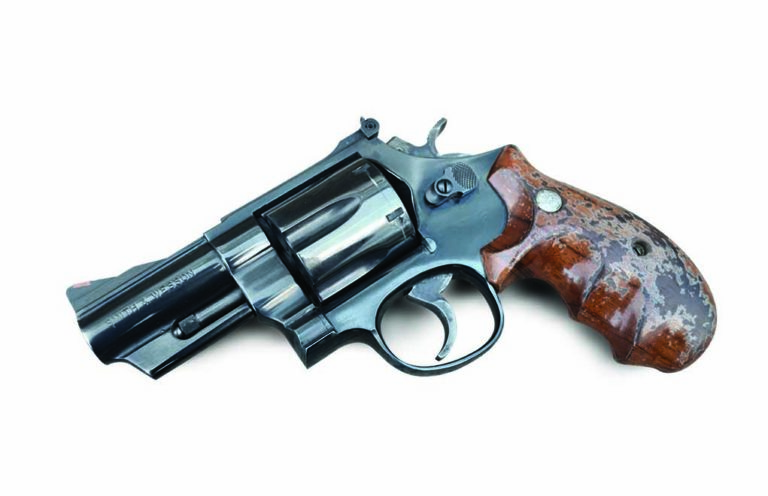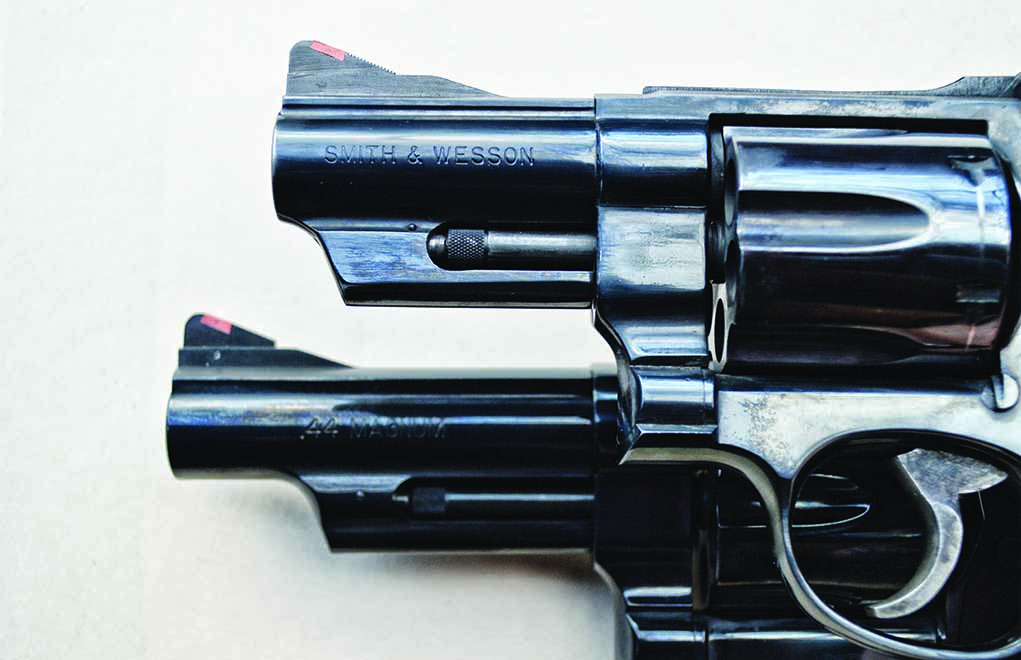
You heard that right … an on-person defensive .44 Magnum. Crazy as it might sound, there are good reasons to carry a compact hand cannon.
Why The .44 Magnum Is A Solid Concealed Carry Choice:
- Nearly double the bullet weight compared to the .357 Mag, thus potentially delivers more energy on target.
- With an exceptionally large diameter, creates a larger and more devastating wound canal.
- The larger diameter bullet doesn't preclude marksmanship but does allow a bit more margin of error.
- Recoil can prove an issue, though is mitigated through practice and ammo selection.
- Guns chambered for the .44 Magnum are generally renowned for their reliability.
Let me say this up front: Concealed-carry guns are personal choices that should be based on what works for the individual—not on popular opinion, gun writer declarations or anonymous voices on Internet sites.
This choice is strictly mine, and mine alone and is one I recommend only for those recoil-insensitive individuals among us. I can only provide you with my reasons (or rationalizations for the cynical among us) for my choice. There; that’s my disclaimer.
When Gun Digest Editor Luke Hartle contacted me to ask what I carry on a daily basis, I have to say that he was actually expecting something along these lines. My carry piece and I have a long history together that dates back to college and the first earnings I made as a prizefighter. It’s a Smith & Wesson Model 29 Lew Horton. You read that correctly—a Model 29, meaning that it’s a .44 Magnum.
For those unfamiliar with the 29, it’s a six-shot, double-action, N-frame revolver in blued steel that’s arguably one of the most aesthetically pleasing revolvers ever made. The Lew Horton edition featured a 3-inch barrel and a rounded grip frame. This one was likely “hatched” in 1985 and is one of 5,000 produced between 1984 and ’85. It’s heavy (relatively speaking), but it should be, because it’s supporting a rather raucous (relatively speaking) cartridge.
It’s also really smooth—Smith & Wesson smooth—despite the much maligned production during the hit-or-miss Bangor Punta days of Smith & Wesson. The action is like velvet; the double-action pull is like passing a hot knife through room-temperature butter; and the single-action pull is light and crisp, with no creep. It breaks at 2.5 pounds.
But why, on Earth, would anyone choose to carry a .44 Magnum on purpose? Good question. I’ll try my damnedest to answer it.
The ‘Stopper’
Early on (for those who remember the days of police officers carrying revolvers), in the hands of law enforcement officers, the .357 Magnum earned a reputation as a stopper—stoked with 125-grain hollow-points with a full head of steam.
What constitutes “stopping” a perpetrator? In this context, it clearly means incapacitation, thereby eliminating the threat. The .357 was loaded hot; it was fast-stepping and violently expanding. The statistics of the day clearly reflected what was most in use at the time, and the .357 was heavily represented. The .44 Magnum never really made its mark (despite “Dirty Harry” Callahan’s best efforts), because the reality was such that no one really carried a .44 Magnum—or rarely did so—so the .44 Magnum is underrepresented in the statistics of one-shot stops.

My reason for choosing the .44 Mag is because it’s built on the same concept as the .357 (high velocity and violently expanding), but the .44 Mag takes it further by nearly doubling the bullet weight (in standard configuration) and significantly increasing the bullet diameter.
Recoil: It Kicks
Now, let’s talk recoil, because I suspect this will be the biggest criticism the scrutinizers will put forth loudly. Yes, it kicks. It’s a .44 Magnum, loaded with what I like to call “proper” .44 Magnum loads, so the kicking part is to be expected. This is where familiarity rears its head. I have owned this revolver for more than 30 years and have put a lot of rounds downrange with it. Also, if you know anything about me, you’ll see that I have more than an unhealthy obsession with large-caliber revolvers and, in fact, I hunt large game (sometimes really large game) with revolvers at every opportunity. Frankly, in my twisted, little paradigm, the .44 Mag is pretty much an entry-level cartridge. I also have a bit of numbness between my ears that enables me to shoot reasonably heavy-recoiling revolvers with little ill effect (at least that’s my wife’s explanation).
Make Your Day With The .44 Magnum:
- Ruger 77/44: A Masterful .44 Magnum Rifle
- Redhawk vs. Super Redhawk: Which Is Ruger’s Best .44 Magnum Revolver?
- HandLoading .44 Magnum Ammo For Hunting
- .45 Long Colt vs .44 Magnum
The factory grips actually work quite well with my hands and, despite my lousy up-close vision, the factory Smith & Wesson white outline rear and red insert front sight combination is more than adequate for my visual shortcomings. However, this piece was meant for up-close-and-personal work; in that capacity, it works exceedingly well. Muzzle blast is noticeably more present due to the short barrel. Again, that’s the price to pay for such a configuration.
Accuracy is Smith & Wesson good. As I mentioned previously, the Bangor Punta ownership days were hit or miss from a quality-of-production standpoint, but this one’s clearly one of the good ones. I don’t know whether it’s the additional attention to detail provided by Lew Horton’s involvement or that this particular example was “produced on a Wednesday,” but it will shoot a wide array of factory fodder with more-than-acceptable accuracy; and, in the case of some loads, it will deliver exceptional accuracy.
Caliber Size Does Matter
In this day and age of high-capacity plastic wonder pistols, it seems archaic to carry a six-shot revolver. Some newer revolvers even feature eight-shot capacity! With the popularity of some of the “lesser” cartridges (such as the 9mm) comes a level of investment and development in maximizing the potential of these defensive cartridges. Taking nothing away from the effectiveness or usefulness of the large-capacity configurations—or the fact that nearly anyone with even minimal grip strength can shoot them (and shoot them well)—they’ll never have the terminal effectiveness of a properly loaded .44 Magnum. You can take that to the bank.
With all else being equal, size matters. A large caliber doesn’t preclude shot placement, but it will give you a bit of a margin of error and will also produce significantly more damage—again, assuming that all else is equal, such as bullet type/construction and velocity.

Do you want to know what my answer to high capacity is? Marksmanship. It’s better to hit with one shot that’s well-placed than to spray your target in hopes of a significant hit. There’s also a false sense of security that 15 rounds might impart to the shooter. I’m not arguing that having more rounds can be an asset; I’m merely saying that perhaps knowing you have fewer rounds forces you to take more care when obtaining your sight picture and sight alignment.
Uncompromising Reliability
That said, there’s a level of reliability inherent to the design that no auto-pistol can ever hope to achieve. Yes, I know there are plenty of great semi-autos out there that are extremely reliable, but the simplicity of the revolver design ensures uncompromising reliability.
However, some designs simply point better than others, and the Model 29 just works for me (this is a scientific measure), and I’ve had more than three decades to become really intimate with this particular revolver.
A concealed-carry .44 Magnum? Sure. Why not?
Expand Your Knowledge on Concealed Carry
- Best Concealed Carry Gun [Field Tested]
- Best Concealed Carry Gun for Women
- Must-Have Concealed Carry Upgrades
- Best Concealed Carry Insurance – CCW Insurance Options
- Concealed Carry Optics – Red Dot, Green Dot, or Iron Sights?
The article originally appeared in the 2020 Concealed Carry issue of Gun Digest the Magazine.

Next Step: Get your FREE Printable Target Pack
Enhance your shooting precision with our 62 MOA Targets, perfect for rifles and handguns. Crafted in collaboration with Storm Tactical for accuracy and versatility.
Subscribe to the Gun Digest email newsletter and get your downloadable target pack sent straight to your inbox. Stay updated with the latest firearms info in the industry.

![Best Concealed Carry Guns In 2025 [Field Tested] Wilson Combat EDC X9S 1](https://gundigest.com/wp-content/uploads/Wilson-Combat-EDC-X9S-1-324x160.jpg)


![Best 9mm Carbine: Affordable PCCs [Tested] Ruger Carbine Shooting](https://gundigest.com/wp-content/uploads/Ruger-Carbine-Shooting-100x70.jpg)
![Best AR-15: Top Options Available Today [Field Tested] Harrington and Richardson PSA XM177E2 feature](https://gundigest.com/wp-content/uploads/Harrington-and-Richardson-PSA-XM177E2-feature-100x70.jpg)

Notice how worn the butt is.
I would love to see a “Paul Harrell” rebuttal of this article 🙂
Paul would say to each his or her own. Just don’t try that at home, he’s whatcha call a professional.
Godsspeed to paul. I hope he beats the big C.
Jovino Effector. That’s what I would like them to make. Big bore but more concealable.
No doubt the .44 mag. is a top notch caliber. My only worry about it’s use for EDC is, I believe that an over zealous prosecutor could make a lot of “hay” in court about such a powerful round being used against a human target. With the lack of knowledge in the general public about guns, in general, a person using a .44 mag. could find himself in prison based solely on his choice of caliber.
One could also argue that because the revolver only holds 5 or 6 rounds the larger caliber off sets the stopping capabilities of smaller calibers holding 10 or more rounds. Where as one shot with the 44 may stop some one where 2 or 3 shots with a smaller caliber might be the scenario …
If I could have any carry piece I wanted, I’d make a call to Hamilton Bowen for a 4″ blued Redhawk in the .50 Bowen Special. Now we’re down to five shots but up to a 400 grain, 1/2″ pill moving out at 800 fps. Being left handed, I’ve always stayed with revolvers. No shell casings flying across my eyes, and I think the conventional swing out to the left cylinder actually works better for left handed than right handed shooters. No weird gyrations for me; the revolver is rotated in one plane and I have hold of the cylinder during the entire reload. The one thing I could wish for though, is a cylinder latch on the right side of the gun, where I could hit it with my left thumb.